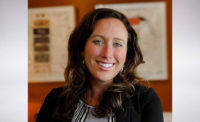Name/Title/Company: Andi Burnham, principal and director of energy services, Delta E Consulting
Age: 35
Educational Experience: Bachelor’s degree in engineering, mechanical engineering
Professional Credentials/Accreditations: Professional engineer (P.E., mechanical), LEED AP BD+C, Building Energy Modeling Professional (BEMP), and High-Performance Building Design Professional (HBDP)
Organizational Affiliations/Achievements/Awards: ASHRAE member, International Building Performance Simulation Association (IBPSA) member and local chapter event organizer
What does your day-to-day job entail?
As a co-founder of a new engineering consulting firm, in my role as the director of energy services, my day-to-day work often involves a combination of communicating with internal and external teams. I enjoy spending a good amount of time reviewing energy and carbon technical analyses and reports or researching new technologies and concepts. Some days I will be busy developing a presentation to help educate our industry about code and policy changes, while other days I may support the team in developing a decarbonization plan with a new perspective. Additionally, I support business development and marketing, helping with proposals, and reviewing studio financial performance.
What caused you to/when did you fall in love with engineering?
I’ve always been curious about how things work, and “take apart projects” have always been a favorite of mine since childhood. Mechanical engineering was a natural fit because it felt like a broad foundation that could develop or evolve into any number of career paths. My passion for energy analysis was ignited during two years of an energy modeling internship in college, as I understood how important energy usage is to the built environment and its impact on the climate crisis. I went full-time into energy modeling after graduation and never looked back.
What has been the most rewarding/proudest aspect of your engineering career?
I’ve had the chance to work on some incredible projects during my career, including energy modeling for the Empire State Building and working on multiple Living Building Challenge projects. That said, some of my proudest professional accomplishments have been when I am able to zoom out beyond specific projects to influence the codes and policies that are helping encourage broader decarbonization efforts.
What challenges do women face in this profession? Can you give a personal example? Why aren’t there more women in engineering? How can we increase the number of women in engineering?
When it comes to increasing the pipeline to HVAC engineering, many challenges exist. For mechanical engineering, specifically, there are challenges with how people perceive the profession and the opportunities it provides. Many people are more likely to think cars than chillers when they think about mechanical engineers. Despite buildings and HVAC being huge markets, they are often less visible to young people thinking and dreaming about what their careers could look like. Many of these jobs are not as well-promoted as other career paths, especially newer and more niche roles, like energy/carbon modeling and analysis.
I also believe inclusive requirements and language used within job ads limit candidate pools when hiring, leading to missed opportunities. The common statistic about women being less likely to apply for jobs if they don’t meet 100% of the requirements resonates with my personal experience, and I work to make sure my hiring job descriptions are written in a way that casts a wider and more inclusive net.
How many years have you been active in the engineering sector? What’s changed the most in that time? What’s changed the least?
I’ve been in the architecture, engineering, and construction (AEC) industry for around 13 years, plus time at an internship during school. In that time, sustainability has gone from being a niche “add-on” to a core driver of many projects. Many clients now have internal environmental, social, and governance (ESG) requirements that may go beyond what’s required by code or even the market in some cases.
What hasn’t changed is that every client and project has their own unique drivers and opportunities. It’s important to listen closely at all times.
You have experience with design and modeling. How do they differ, and which do you prefer?
One of the first things I learned when I started my career is still true: All models are wrong, but some models are useful. Design and modeling are so related, and both are important to achieving optimized best outcomes for building owners. Having experience with energy analysis teaches engineers to think outside of the “design day” box. It’s critical to evaluate problems with a holistic mindset, thinking about an overall optimized design in operation. On the flip side, it’s critical for modelers to understand HVAC systems and design constraints to ensure we are appropriately estimating the physics and reality of a system. Many modeling tools require “workarounds,” and it’s critical to understand what you are measuring or comparing to back-checks and validation of the analysis.
You were a founding member of Rushing's Diversity, Equity, and Inclusion (DEI) group. Why is this area so important to you?
I believe most strongly in the “inclusion” and “belonging” aspects of corporate DEI. When people not only feel that they have a seat at the table but also that their voices are being heard, that opens the door to all kinds of magic. You get stronger teams and more creative, better outcomes when people with diverse perspectives and backgrounds work together.
What drives/motivates you every day?
I believe the climate crisis is real, and I want to be part of the solution. I see an important part of my work as helping people consider and understand long-term risks as they make major decisions about their projects. That can include educating owners about the momentum around building performance standards (existing building operating energy or greenhouse gas limits) when they are thinking about the life cycle of their 50-plus-year assets.
What remains on your engineering bucket list — what do you aspire to do that you haven’t accomplished yet?
I would love to work on a project with a large-scale wastewater heat recovery system connected to a city sewer main. (Google the False Creek District Energy System in Vancouver if you want to read about an awesome example!) I’m so excited about the potential of larger-scale energy exchange systems — the future involves thinking beyond the footprint of the buildings we design.
What’s one thing no one knows about you?
I finished my undergraduate degree a few credits short of a Southeast Asian Studies minor.
List any mentors who’ve helped you succeed and describe precisely how they’ve shaped your success.
During my first week at a new job, Jim Wermes told me I was going to be thrown into the deep end of the pool, but that lifeguards were on duty, and all I had to do was wave my arms. It created such a safe space for me to learn and grow, and I truly learned that the only “dumb” questions are the ones you don’t ask.
Jim Wermes and Jeff Wurmlinger always made sure I was not overlooked when it came time to allocate project tasks and growth opportunities.
Phil Beadle was not only a patient technical mentor, he also looked out for me and advocated to make sure I was not disproportionately given (or volunteering myself for) administrative tasks as the only woman on the team.
I chose to move from the Wild West of Phoenix to Seattle, in large part because of an increasing realization and understanding of the importance of energy codes and policy. Eric Vander Mey’s active involvement in the volunteer-driven code development process of Washington state helped me get involved in what can be a daunting process.
Scott Rushing also taught me that excellence is earned incrementally by learning on every project and carrying forward lessons to do better every time.
What advice do you have for prospective female engineers considering entering the field?
Don’t be afraid to ask questions. Know that your diverse experience and perspective adds value.
Be mindful about setting boundaries for nontechnical work just because no one else is raising their hand. There is a time and a place for being a good co-worker by taking on things like note-taking, lunch-and-learn organizing, and coffee-making, but calibrate the amount of work you accept to the amount you see peers and male colleagues taking on.





